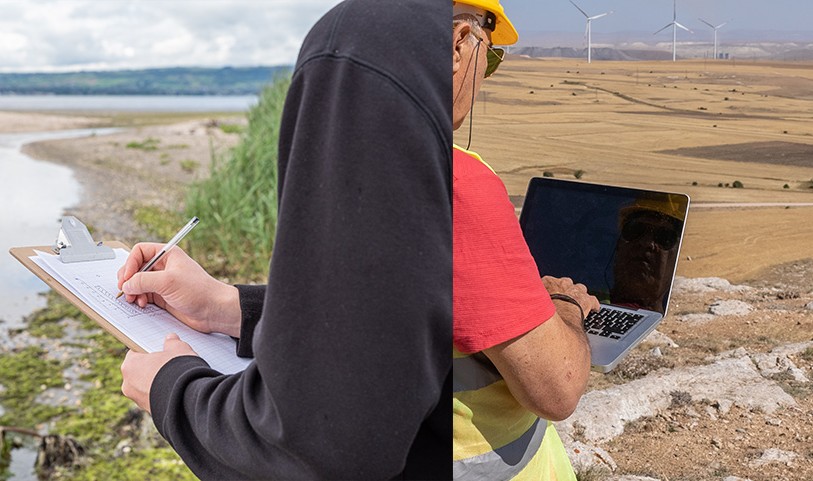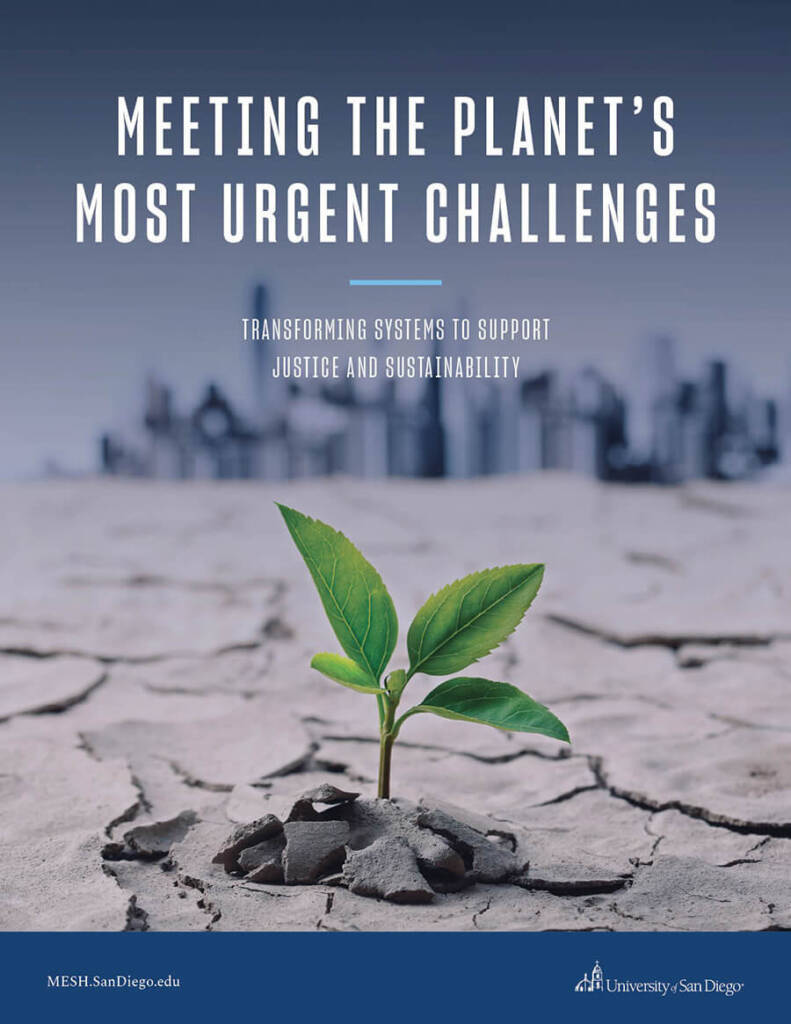Looking to help build new solutions to protect and restore our environment? Then you may be perfect for a career as an environmental engineer or an environmental scientist.
While both STEM-based roles focus on addressing environmental issues, there are some differences — from duties and responsibilities to work environments, career trajectories and salaries.
Your choice of career may largely depend on what you believe you can specialize in and the work you’re interested in doing. In this article we review both fields to see where they align and how they differ, and offer some helpful direction for your future career.
What Is an Environmental Science Degree?
An environmental science degree focuses on the study of the environment to gain a comprehensive understanding of the natural world and the impact of human activities. Environmental science is a multidisciplinary field, integrating principles from a range of scientific disciplines, including ecology, biology, oceanography, atmospheric science, geology, chemistry and more.
The goal is to train scientists how to identify, understand, assess and address environmental issues — whether natural or caused by humans — and to develop science-based solutions. An environmental scientist is primarily a research position; most engage in field work to collect data and then use various analytical techniques, statistical methods, geographic information systems (GIS) and other tools to interpret patterns and trends.
Based on their findings, environmental scientists will make recommendations for policy changes, suggest areas for further research or provide assistance on projects aimed to improve the health of the environment, wildlife or human populations.
For more details, see our full post on how to become an Environmental Scientist.
What Is an Environmental Engineering Degree?
An environmental engineering degree focuses on the application of scientific and engineering principles to address environmental challenges and promote sustainable development. Its primary goal is to train engineers how to develop and implement solutions to protect and regenerate essential natural resources (water, air, soil, etc.) and to enable equitable societal development while minimizing negative impacts on the environment.
The exact responsibilities of an environmental engineer will depend on the specific line of work, industry, company and responsibilities. Similar to environmental science, environmental engineering is an interdisciplinary field and can employ many different engineering principles, including bio-engineering, chemical engineering, hydro engineering, geotechnical engineering and more. Environmental engineers may also engage with areas related to conservation, waste management, water treatment and civil engineering.
Environmental engineers work to design and implement better infrastructure, technology and operations that reduce the risk of environmental contamination and pollution while fostering a more resilient and environmentally conscious society.
For more details, see our full post on how to become an Environmental Engineer.
Environmental Science vs. Environmental Engineering: General Differences
Though environmental engineers and environmental scientists are both working toward the same general purpose — protecting and restoring the environment — their fields differ in focus, methodologies and goals.
In general, scientists engage in research to discover new knowledge and develop a deeper understanding of the world. Engineers, in contrast, apply existing knowledge to solve practical problems in the hope of achieving specific outcomes.
Career focus:
- Environmental scientists focus on the collection and analysis of data to inform their understanding of certain phenomena. They form hypotheses about why certain things are happening and then make assessments about those hypotheses based on information they gather from the environment. For example, an environmental scientist may investigate what’s causing the sudden erosion of soil or the contamination of a water supply.
- Environmental engineers focus on how to apply the recommendations of scientists, technicians, government regulators and other professionals to produce desired outcomes. Engineers utilize their knowledge and experience to design and develop plans or projects that can solve real-world issues. For example, the engineer would take a scientist’s conclusions about the source of water contamination to engineer a solution on how to remove the existing contaminants and prevent future pollution.
Methodologies:
- Environmental scientists and technicians will often split their time between lab work and field work. Those who do field work will study natural resources, biomes or wildlife for signs of changes and collect samples for laboratory analysis. While some scientists do most of their analysis entirely in the field, others may work within laboratory settings to test samples and analyze data collected from the environment. For example, a scientist may take soil and water samples and analyze them in the lab to determine the level, type and possible source of contamination.
- Environmental engineers use the information from scientists, researchers and technicians to make decisions on project designs, development strategies and new construction. They may also collaborate with other professionals such as health officials, urban planners and regional directors to plan projects that support environmental and community health and safety. The engineer will rely on modeling, simulation and decision-supporting tools to design and build a solution and may even work onsite to ensure that all environmental policies and regulations are being followed.
Goals:
- Environmental scientists look to prove or disprove a hypothesis so they may make recommendations to facilitate change or enact future benefits. Their primary goal is to document their results in order to present them to other professionals for recommended courses of action. This could include directions for other scientists on how to conduct additional research, advice to policy makers to update laws and regulations or guidance for engineers on how to build effective solutions.
- Environmental engineers want to create practical solutions that can be successfully implemented in the real world. Their goal is to implement strategies and make recommendations on environmental solutions that are efficient, achievable and functional. Once a solution has been selected, the engineer will design, build and/or oversee the implementation of the project to help address any issues and ensure that it meets specific standards.
Environmental Science vs. Environmental Engineering: Required Education and Experience
Both areas of study are STEM fields and will require students to earn a bachelor’s of science in environmental science, environmental engineering or a related field such as biology, chemistry or physics. As students continue in their careers, they’ll take more technical classes specific to their field of study.
- Environmental scientists will likely take courses in earth sciences, mathematics, natural sciences, biology, statistics and research methods. Depending on their career goals they may also take elective courses in economics, public policy, population ethics and political theory.
- Environmental engineers may take courses in thermodynamics, hydraulics, mechanics, algebra, calculus and computer modeling. Depending on their career goals they may also take elective courses in hydrology, ecological engineering, geotechnical engineering, water resources engineering, transportation engineering or solid waste management.
While a master’s degree isn’t often required for entry-level positions, it’s typically preferred or even required for higher-level positions. Those interested in a research or teaching career will likely need to pursue a doctoral degree.
See our companion blog post Top 5 Sustainability Master’s Degrees for a closer look at environmental science and sustainable engineering degrees, including sample programs and courses.
As for necessary work experience, specific job requirements will vary depending on the field, level of seniority and type of organization.
- Many environmental scientist jobs require around four years of experience working as an intern, research assistant or environmental specialist. Additionally, some positions may require six months to a year of job training. Industry certifications from organizations such as the National Registry of Environmental Professionals (NREP) or the Ecological Society of America (ESA) aren’t usually required but could be advantageous.
- Engineer jobs may require a year to two of experience as a research assistant, intern or project engineer. Some positions may require one to three months of job training. Attaining an environmental engineer certification like the Engineer In Training Certification (EIT) from the National Council of Examiners for Engineering and Surveying or certifications from organizations such as such as the Institute of Industrial Engineers (IIE) and the American Society for Engineering Management (ASEM) can also showcase experience and expertise.
Environmental Science vs. Environmental Engineering: Career Comparison
Environmental scientists and engineers can find employment in the private, nonprofit and government sectors. According to the U.S. Bureau of Labor Statistics, both the Environmental Scientist and Environmental Engineer careers are projected to grow 6 percent from 2022 to 2032, faster than the average for all occupations.
Salaries for both positions will vary depending on position, location and level of experience. As of January 2024 the BLS report on the median annual wage for environmental scientists and specialists was at $76,480 and the median annual wage for environmental engineers was at $96,530. Salaries do fluctuate over time, so these values may change.
Earning a bachelor’s or master’s degree can help make you a viable candidate for many different positions. Scientists and engineers can even switch careers depending on their experience and a job’s requirements.
Other possible job titles for environmental science degrees include:
- Environmental Technician — Supports environmental scientists, engineers and other professionals in monitoring, assessing and managing environmental conditions. They collect data that informs decision-making processes related to environmental protection, conservation and management.
- Environmental Specialist — Employs a combination of technical expertise, regulatory knowledge and project management skills to promote environmental sustainability and minimize negative impacts on the natural world. They can work with private industry, nonprofit organizations or government agencies.
- Environmental Manager — Oversees and implements policies, programs and initiatives related to environmental sustainability and compliance. Their role is multifaceted and involves strategic planning, regulatory adherence and fostering a culture of environmental responsibility.
Possible job titles for environmental engineering degrees include:
- Civil Engineer — Plans and designs the human-built environment and supporting communities. They design, build, supervise, operate and maintain public and private projects and systems that can include roads, dams, tunnels, bridges and energy and water transfer systems.
- Public Health Engineer — Their work addresses public health issues, which can include water supply, sanitation and environmental health. They design, implement and manage infrastructure and systems that promote public health and prevent the spread of diseases.
- Wastewater Project Engineer — They plan, design, implement and manage wastewater infrastructure projects that treat and dispose of wastewater in an environmentally sustainable and compliant manner. Their work contributes to environmental protection, public health and overall community well-being.
Environmental Science vs. Environmental Engineering Comparison Chart
| Environmental Science | Environmental Engineering | |
|---|---|---|
| Focus and goals | Collect and analyze data to assess hypotheses and make recommendations to facilitate positive change. | Apply recommendations and existing knowledge to develop solutions that can address issues in the environment. |
| Methodologies | Collect samples and data in the field Analyze information to draw conclusions Write reports that detail recommendations | Utilize knowledge and tools to design and develop built solutions Oversee implementation of the solutions and resolve issues |
| Required education | B.S. in environmental science or related fields such as biology, chemistry or physics. | B.S. in environmental engineering or related fields such as biology, chemistry or physics. |
| Sample courses | Earth sciences Mathematics Natural sciences Biology Statistics Research methods | Thermodynamics Hydraulics Mechanics Algebra Calculus Computer modeling |
| Sample electives | Economics Public policy Population ethics Political theory | Hydrology Ecological engineering Geotechnical engineering Water resources engineering Solid waste management |
| General required experience | Around four years | One to two years |
| Projected career growth through 2032 | Faster than the average for all occupations at 6% | Faster than the average for all occupations at 6% |
| Median salary | $76,480 | $96,530 |
| Possible careers | Environmental Scientist Environmental Technician Environmental Specialist Environmental Manager | Environmental Engineer Civil Engineer Public Health Systems Engineer |
Explore the MESH Program at USD
Both environmental scientists and environmental engineers do their best work in coordination with other professionals. Aside from how their own work informs each other, scientists and engineers also collaborate with social scientists, public health officials, regulators and various other stakeholders to promote the causes of environmental health and justice.
Taking a transdisciplinary approach to your environmental studies can support your future career, since it can bolster your experience and help you develop a more nuanced perspective on environmental matters. The University of San Diego’s Master of Science in Engineering, Sustainability and Health is just such a program created for those looking to collaborate with like-minded professionals passionate about the protection and revitalization of our ecosystems.
If you’re looking for ways to apply your skills to address our most pressing environmental and social problems while coordinating with skilled professionals from other fields, we invite you to explore the MESH program. Contact us today to learn how we all can create better solutions for the environment.
FAQs
Which Degree Is the Best Fit for You?
Do you relish trying to figure out what is causing specific problems and discovering new knowledge? Or do you prefer to actively build and design solutions that can positively impact the environment and human health?
Allow your preferences and talents to guide you in choosing a career path — but keep in mind that many of these skills are transferable and applicable across disciplines. Earning a degree in either environmental engineering or environmental science can qualify you to work in various roles that work toward restoring and regenerating our environment.




